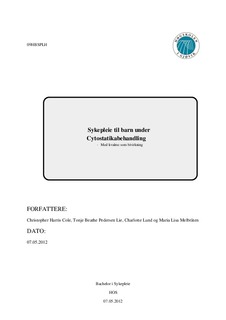| dc.contributor.author | Cole, Christopher Harris | |
| dc.contributor.author | Lie, Tonje Beathe Pedersen | |
| dc.contributor.author | Lund, Charlotte | |
| dc.contributor.author | Melbråten, Maria Lisa | |
| dc.date.accessioned | 2012-06-27T08:25:42Z | |
| dc.date.available | 2012-06-27T08:25:42Z | |
| dc.date.issued | 2012 | |
| dc.identifier.uri | http://hdl.handle.net/11250/142831 | |
| dc.description.abstract | NORSK: For pasienter diagnostisert med kreft, er kjemoterapibehandling med kvalme som bivirkning et kjent fenomen. Selv om man i dagens medisinske verden har stadig fler effektive antiemetika, er det fremdeles mange pasienter som opplever kvalme og oppkast som en bivirkning av cytostatikabehandlingen. Hovedhensikten med dette studiet er å finne ut hvilke ikke-medikamentelle tiltak som er effektive for å forebygge cytostatikaindusert kvalme hos barn, og hvordan sykepleieren kan bidra til å redusere denne plagsomme bivirkningen. Oppgaven er et litteraturstudie hvor vi har benyttet følgende søkeord: nausea, chemotherapy, children, prevent, intervention, managing, nutrition, measure, cancer, coping og emesis. Diskusjonen inneholder ulike pasientbeskrivelser av følelsen kvalme, mestringsstrategier, viktigheten av informasjon, kunnskap om ikke-medikamentelle tiltak, og ulike alternative behandlingsmetoder. Konklusjonen er at kvalme må behandles individuelt hos hvert barn. Sykepleieren har en viktig rolle i fremtiden for å skape vellykkede strategier for pasienter som sliter med cytostatikaindusert kvalme, og ikke medikamentelle tiltak bør vies mer oppmerksomhet. | no_NO |
| dc.description.abstract | ENGELSK: For patients diagnosed with cancer, chemotherapy treatment with nausea as side-effect is a known phenomenom. Even though the medical science is developing rapidly with more effective antiemetics, there is still a problem with patiens experiencing problems with nausea and emesis as a side effect of the chemotherapy treatment. The main purpose of this study was to find out which non-medical measures that are effective to prevent chemotherapy-induced nauseas with children, and how nurses can help reducing this bothersome side effect. The study is written as a literature study where we used the following keywords:nausea, chemotherapy, children, prevent, intervention, managing, nutrition, measure, cancer, coping, emesis. The result tells us of different patient descriptions of feeling nausea, coping strategies, importance of information, knowledge of non-medical measurements and different alternative treatment to handle the quaeesy feeling. The conclusion is that nausea has to be treated individually for each child. The nurse has an important role in the future with creating successful strategies for patients that struggles with chemotherapy-induced nausea, and non-medical measurements should get more attention in the future. | no_NO |
| dc.language.iso | nob | no_NO |
| dc.subject | bern | no_NO |
| dc.subject | kreft | no_NO |
| dc.subject | cytostatikabehandling | no_NO |
| dc.subject | kvalme | no_NO |
| dc.title | Sykepleie til barn under cytostatikabehandling med kvalme som bivirkning | no_NO |
| dc.title.alternative | Nursing for Children under Chemotherapy-treatment with nausea as a side effect | no_NO |
| dc.type | Bachelor thesis | no_NO |
| dc.subject.nsi | VDP::Medical disciplines: 700::Clinical medical disciplines: 750::Oncology: 762 | no_NO |
| dc.source.pagenumber | 58 | no_NO |
